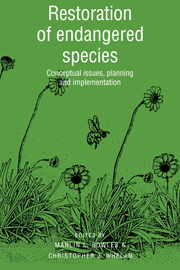I - Conceptual issues in restoration ecology
Published online by Cambridge University Press: 27 January 2010
Summary
Conservation biology has been described as a mission-oriented science aimed at preserving biological diversity (Soulé 1986, Temple et al. 1988, Gibbons 1992). Thus, conservation biology may be simply envisioned as maintenance or preservation, much like keeping an automobile well-lubed, with proper tire inflation, clean filters, adequate antifreeze, etc. Restoration ecology, an important and growing discipline within the field of conservation biology, aims to reestablish or rehabilitate damaged or lost plant and animal populations or species assemblages native to the area of interest (Jordan, Gilpin & Aber 1987). Returning to the metaphor of the automobile, this is more like going to a junkyard, purchasing the component parts, and reassembling a working automobile. Restoration ecology, like much of conservation biology, often relies on fundamental autecological knowledge of the target species (Soberón 1992), but restoration ecology also provides unique opportunities for testing basic ecological theories (Jordan et al. 1987). Thus, restoration ecology can also be viewed as a truly powerful research technique, for surely, restoration of a viable population or species assemblage demonstrates ecological understanding as nothing else can.
Restoration ecology straddles an interface between the economic and political demands of human society, and the biological requirements of the species or communities targeted for restoration. Hence, conceptual issues important to restoration ecology range from the sociopolitical, including organization and management of restoration efforts, to the biological, such as population viability analysis, conservation genetics, metapopulation biology, landscape ecology, etc. As Brown (Chapter 14) points out, restorationists cannot ignore the fact that society will suffer missed economic opportunities when land is dedicated for restoration, as opposed to, say, a shopping mall or a housing subdivision.
- Type
- Chapter
- Information
- Restoration of Endangered SpeciesConceptual Issues, Planning and Implementation, pp. 1 - 8Publisher: Cambridge University PressPrint publication year: 1994
- 2
- Cited by



